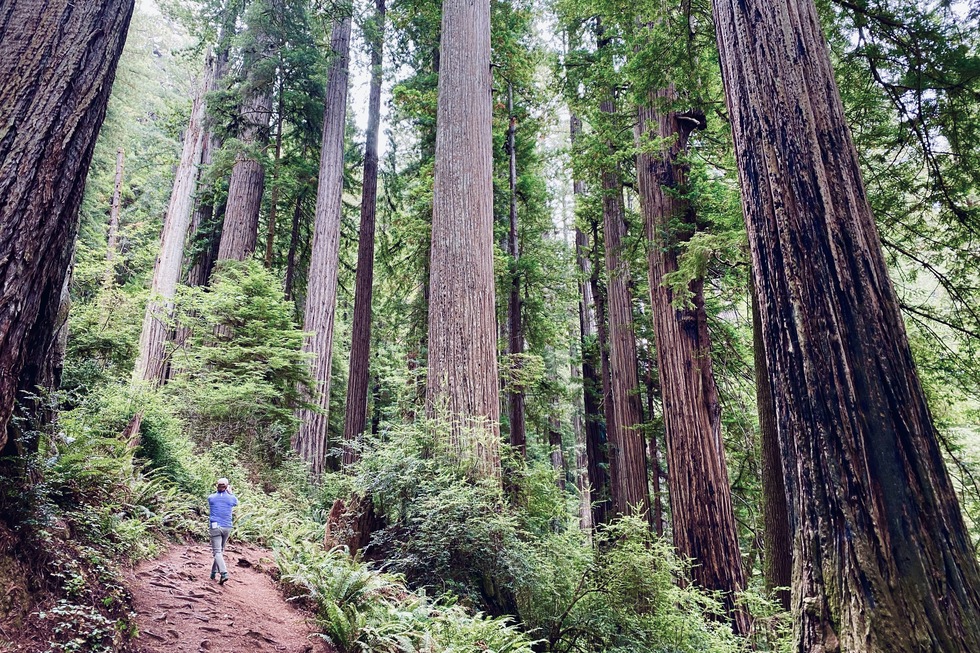Where is the redwood forest? If you had asked that question in mid-19th century California, the answer would have been "Where aren’t there redwood trees?”
Some 2 million acres of these magnificent trees covered massive stretches of California, Oregon, and Washington State back then. Sadly, because of rampant logging in the late 19th and early 20th centuries, just 5% of those redwood trees are still in existence today.
Almost all are concentrated in 43 redwood parks across California. The mightiest of those parks: Redwood National and State Parks (composed of Redwood National Park and separate redwood state parks—we’ll explain below). Taken together, it's a wondrous place to visit—a redwood park that takes “forest bathing” to an entirely new level.
What follows is a primer for those hoping to visit this splendid redwood park, learn more about giant redwood trees (the tallest and biggest living beings on earth), visit a worthwhile neighboring redwood park (Avenue of the Giants), and perhaps drive through a redwood tree. We’ll also take a look at the weather in Redwood National Park and camping in Redwood National Park.
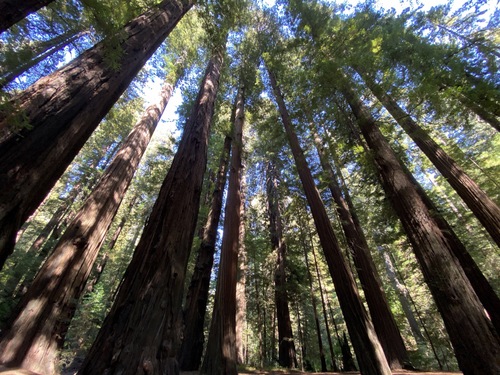 (Redwood tree canopy at the Avenue of the Giants in California)
(Redwood tree canopy at the Avenue of the Giants in California)
What to Know About the Redwood Tree
Just how tall are redwood trees?
The biggest of these trees reach over 380 feet in height—equivalent to a 30-story building. The average mature redwood tree usually stands between 200 and 250 feet tall (still pretty impressive), with diameters of 10 to 15 feet.
That’s a remarkable accomplishment for a plant that often grows from a seed the size of a tomato seed. We say “often” because the giant redwood tree is one of earth’s few species that can regenerate without sexual reproduction. A redwood tree can sprout from the roots of a downed tree or from a tree stump as a clone of the original.
Why the redwood tree grows so tall is a mystery. The same goes for the surprising communication systems scientists have discovered in the intertwined root networks of neighboring redwood trees.
Fossil evidence shows that the redwood tree was around some 160 million years ago, during the age of the dinosaurs. The tree can live to up to 2,000 years.
About Redwood National and State Parks
The only state-and-federal hybrid of its kind in the U.S. national park system, Redwood National and State Parks merges three 1920s-era state redwood parks (Prairie Creek Redwoods State Park, Del Norte Coast Redwoods State Park, and Jedediah Smith Redwoods State Park) with Redwood National Park, which was signed into existence by President Lyndon B. Johnson in 1968. The union of the four occurred in 1994, and the resulting mega park protects 133,000 acres and 45% of the coastal redwood trees in existence today.
National Park Service (NPS) rangers and state park rangers work together as well as separately to lead hikes, staff ranger stations, and safeguard the redwood trees, along with a growing population of elk, 37 miles of rugged coastline, grassland prairie, and a wide array of other flora and fauna.
Redwood National and State Parks spreads over both Humboldt and Del Monte counties near the Oregon border, in the northernmost quadrant of California. Hyperion, the tallest redwood tree known to man, lives in the park, though visitors are not allowed to come within a mile of the tree since 2022, after a number of yahoos did damage to the surrounding ecosystem.
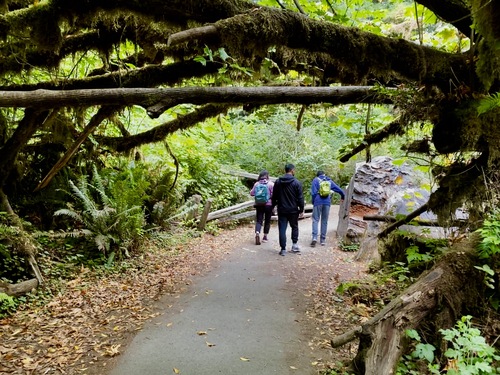 (Hikers on a trail in Redwood National and State Parks in California)
(Hikers on a trail in Redwood National and State Parks in California)
When to Go
Redwood National Park weather, and, to a lesser extent, crowds, are the key factors in determining when to visit.
Since this is coastal California, it rarely gets bitterly cold here. Temperatures tend to settle in the mid-40s Fahrenheit from December though early March.
But these redwood trees wouldn’t have survived for millennia if they hadn’t gotten a lot of rain, and in the winter months the downpours can be torrential. Because of the volume of rain, many parts of Redwood National Park close to visitors in deep winter. We should note that fog is also a big part of the weather systems here; the redwood tree can access about 40% of its daily water needs from fog.
To enjoy the best weather in Redwood National Park, you’ll want to visit in early fall and late summer, the warmest times of year in this region. In August, September, and October, temperatures tend to hover in the mid-60s F to the low 70s.
Redwood National Park weather is slightly cooler in June and July, when the crowds are at their thickest. But since this is the 21st least-visited park in the U.S. national park system, Redwood National Park never feels overrun, even when crowds are at their apex.
The weather in Redwood National Park is chillier still in spring, but since this redwood park is awash in wildflowers then, it’s also the most photogenic time of year to visit.
Hiking in Redwood National Park
There are a number of activities visitors can engage in at Redwood National Park, from tide pooling along the coast to cycling and driving the Newton B. Drury Scenic Parkway. But to get up close and personal with the park's marquee attractions—the giant redwood trees—hiking is the way to go.
Here are the best hikes in the park.
Cathedral Trees Trail
The name doesn’t lie: Hike this loop and you’ll be blessed with sightings of cathedral-high old growth redwood trees. And that happens from the very start, too—the route commences near the Big Tree, an unimaginatively named colossus that scrapes the clouds at 309 feet.
- Difficulty level: Moderate
- Trail length and elevation change: 3 miles, 100 feet
- Location: Prairie Creek Redwoods State Park
-
Frommer’s Redwood National Park Hiking Rating: A+
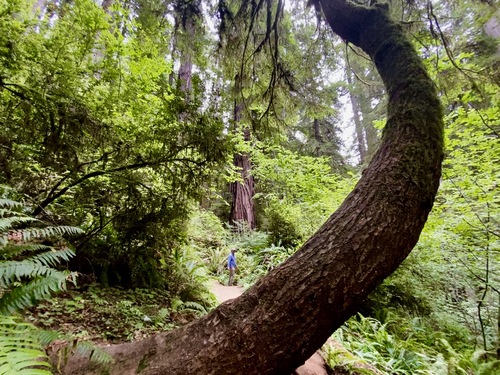 (Cathedral Trees Trail at Redwood National and State Parks in California)
(Cathedral Trees Trail at Redwood National and State Parks in California)
Fern Canyon Loop Trail
Where do filmmakers like Steven Spielberg go when they need a prehistoric-looking setting? Usually to a studio full of green screens. But for a more realistic approach, there's Fern Canyon, whose screen credits include dino docs and Spielberg's The Lost World: Jurassic Park.
Highlights of the trail include a small waterfall and a canyon with 15-foot walls draped in five different types of ferns. There are no redwoods in the immediate area of the trail, but there are many conifers, including Sitka spruce. Most times of the year, this is a dazzlingly green walk.
Important: To hike in Fern Canyon you must get a permit by midnight the day before you hope to hike. And because the number of permits per day are capped, it's smart to get one even farther in advance.
- Difficulty level: Easy to moderate (depending on water levels, as walkers must cross seasonal footbridges over streams)
- Trail length and elevation change: 1 mile, 118 feet
- Location: Prairie Creek Redwoods State Park
-
Frommer’s Redwood National Park Hiking Rating: A+
Coastal Trail + Fern Canyon Loop Trail
This is the very best type of surf and turf. You get the primordial inland landscapes described above, plus views of giant redwood trees and splendid Pacific Ocean and beach vistas to boot. On the bluffs overlooking the sea, many hikers spot sea lions and gray whales.
Several trails form one long system that most hikers interrupt with an overnight at the Gold Bluffs Beach campground.
Important: A permit is required for any Fern Canyon hiking, and cannot be purchased on the day of the hike.
- Difficulty level: Difficult
- Trail length and elevation change: 15 miles, 1,390 feet
- Location: Prairie Creek Redwoods State Park
- Frommer’s Redwood National Park Hiking Rating: A+
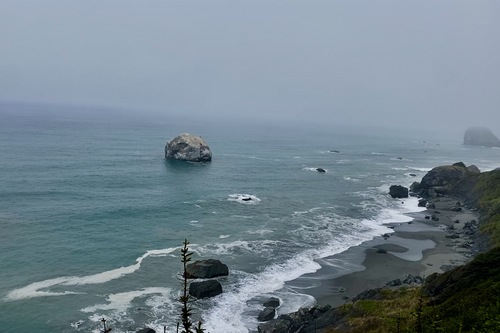 (Coastal section of Redwood National and State Parks in California)
(Coastal section of Redwood National and State Parks in California)
James Irvine Trail
Like the trail above, the James Irvine loop meets up with the Fern Canyon trail and also hits the beach. That variety makes for one of the most popular treks in the park, even though achieving the entire loop will take a full day. As with the two hikes above, you’ll need to obtain a permit by the day before you set out.
- Difficulty level: Moderate to difficult
- Trail length and elevation change: 12 miles, 600 feet
- Location: Prairie Creek Redwoods State Park
- Frommer’s Redwood National Park Hiking Rating: A+
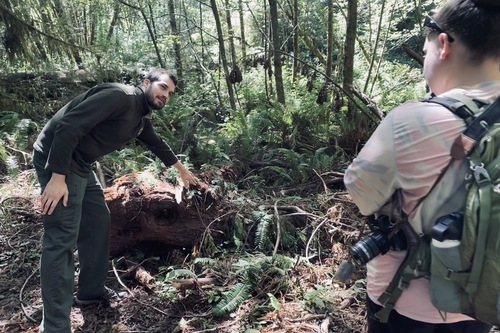 (Ranger-led tour at Prairie Creek Redwoods State Park in California)
(Ranger-led tour at Prairie Creek Redwoods State Park in California)
Lady Bird Johnson Grove Trail
One of the top reasons to choose this trail is the chance to hike in the company of the park’s superb rangers. On daily guided hikes during the summer, visitors learn not only about the natural history behind this spellbinding landscape but also the stories of the humans who fought to protect the giant redwood. If you visit at other times of the year, download an audio version of the tour from the NPS website.
The hike supplies the rare experience of traveling from second growth forest to old growth forest in just a few minutes—an unfolding visual story that’s fascinating to witness.
- Difficulty level: Easy
- Trail length and elevation change: 1.5 miles, 118 feet
- Location: Redwood National Park
-
Frommer’s Redwood National Park Hiking Rating: A
Boy Scout Tree Trail
Twin redwood trees soaring 230 feet in height and measuring 23 feet in diameter are the goal of this hike—and yes, they were discovered by a Scoutmaster in the 1930s. He later brought in his troop to help build the trail.
Passing a number of giant redwood trees, the trail is remarkably tranquil, thanks to the loop reaching deep into the forest, well away from any roads.
- Difficulty level: Easy to moderate
- Trail length and elevation change: 6.1 miles, 535 feet
- Location: Jedediah Smith Redwoods State Park
-
Frommer’s Redwoods National Park Hiking Rating: A-
Damnation Creek Trail
This trail is the one to pick in spring, when it’s blanketed by tens of thousands of rhododendrons. Set against the dark green of the forest, these happy pink blossoms look like they’re glowing from within.
In past years, the trail led from redwood forest to spruce and finally to a narrow beach. But in 2015 the bridge linking the trail to the sands was damaged, and it has yet to reopen, nearly a decade later. Even without the final beachy leg, though, this is a fun trail with much to see.
- Difficulty level: Moderate
- Trail length and elevation change: 5 miles, 1,190 feet
- Location: Del Norte Coast Redwoods State Park
-
Frommer’s Redwoods National Park Hiking Rating: A-
Camping in Redwood National Park
Why yes, you can indeed sleep under giant redwood trees!
The redwood state parks operate full-service campgrounds as well as more primitive offerings. There are also recommendable options near Redwood National Park. Our top picks follow.
Mill Creek Campground
Set within Del Norte Coast Redwoods State Park, this is the largest of the park’s campgrounds. Consequently, it's often easier to snag a reservation here than elsewhere. That doesn't mean it feels crowded, however. Spread out over a large and heavily wooded area, campsites are generally quiet and private.
Many tent sites require a small hike from the parking area to reach, so this may not be the best choice for travelers with mobility issues.
- Accommodates: RVs and tent campers
- Facilities: Hot showers, ADA-accessible bathrooms, campfire center
-
Frommer’s Redwood National Park Camping Score: A
Elk Prairie Campground
The best campsites here are sheltered under giant redwood trees and spaced well apart to keep things serene. A handful of sites are located on the edge of a large meadow—great for spotting elk and gazing at the stars, not so hot for privacy.
The campground is more centrally located than Mill Creek (situated at the north end of the park); Elk Prairie sits right off one of the park’s main roads, with a number of excellent hiking trails starting near the tent sites.
- Accommodates: RVs and tent campers
- Facilities: Hot showers, ADA-accessible bathrooms, campfire center
- Frommer’s Redwood National Park Camping Score: A-
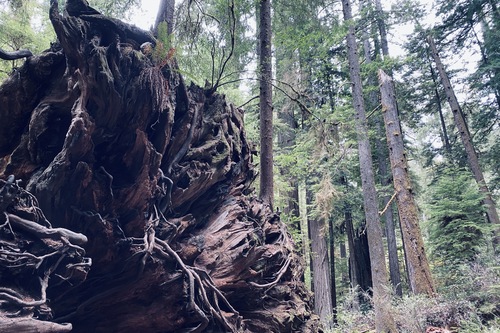 (Fallen redwood tree at Prairie Creek Redwoods State Park in California)
(Fallen redwood tree at Prairie Creek Redwoods State Park in California)
Jedediah Smith Campground
The oldest and tallest trees in the park stand amid this campground (or nearby). Sites are nestled in old growth forests, with the Smith River burbling on one side. However, a number of sites get noise from Highway 199, which runs along the other side of the campground. Crescent City is nearby, making it easy to load up on groceries and other supplies.
- Accommodates: RVs and tent campers
- Facilities: Hot showers, ADA-accessible bathrooms, campfire center
-
Frommer’s Redwood National Park Camping Score: B+
Gold Bluffs Beach Campground
As the name suggests, this is the choice for those who want ocean vistas—and they are spectacular. Most of the sites are fully unsheltered, set in the grasses and dunes behind the beach. As a result, wind can be an issue.
What's more, the facilities here are more rustic than at other drive-in park campgrounds, and the road in is a bumpy, steep, twisty dirt one. Many visitors come specifically to hike through nearby Fern Canyon, an activity that requires an advance permit (as does camping).
- Accommodates: Small RVs and tent campers
- Facilities: Solar showers, non-ADA-accessible bathrooms, campfire center
-
Frommer’s Redwood National Park Camping Score: B+
Panther Flat Campground
The best option among the non-Redwood National Park campgrounds, Panther Flat is about 30 minutes from Jedediah Smith Redwoods State Park, not far from Crescent City. The Smith River flows nearby. Sites are surrounded by trees and are quite serene. Campers have access to flush toilets and coin-operated showers. It’s usually possible to simply drive up and find a campsite here, though advance reservations are offered.
- Accommodates: RVs and tent campers
- Facilities: Showers, ADA-accessible bathrooms, campfire center
-
Frommer’s Redwood National Park Camping Score: B+
A Side Trip to the Avenue of the Giants
If you have limited time, you can skip visiting the Avenue of the Giants, which is basically just a smaller redwood park. Set within Humboldt Redwoods State Park, the avenue makes for a winding road trip through a landscape that's noticeably different from what we've seen so far.
Because the Avenue of the Giants is further inland than Redwood National Park, the look and feel vary significantly. Along the Avenue of the Giants, a 32-mile road with groves on either side, redwood trees tend to be grouped farther apart from one another than in Redwood National Park. And because of the drier climate along the Avenue of the Giants, the forest doesn’t have the same bright green, mossy, fern-filled, primordial look that you get at Redwood National Park.
Instead, the Avenue of the Giants has the aspect of a redwood tree museum, with formal-looking groupings of trees that are striking in their own way. For starters, the Avenue of the Giants has the largest contiguous old growth coastal redwood tree forest in the world, including some 100 redwood trees taller than 300 feet.
The Avenue of the Giants runs parallel to U.S. Highway 101, between Exit 672 and Exit 645. It can be intimidating to figure out just where to stop along the Avenue of the Giants—there are a lot of choices—but we think the following groves and attractions (including a drive-through redwood tree) will give you the best experience.
Allot at least 4 hours to seeing the Avenue of the Giants so that you don’t have to rush and can fit in some nice hikes. Doubling that amount of time is even better.
Bolling GroveIf you’re starting the Avenue of the Giants on its southern end, this will be the first grove you’ll come to. It makes an appropriate introductory stop, as this was the very first swath of land purchased for protection by the Save the Redwoods League in 1920.
The name of the grove is a memorial to Colonel Raynal Bolling, the first high-ranking American officer killed in World War I. You can read about him and about efforts to protect redwood trees on plaques throughout the grove.
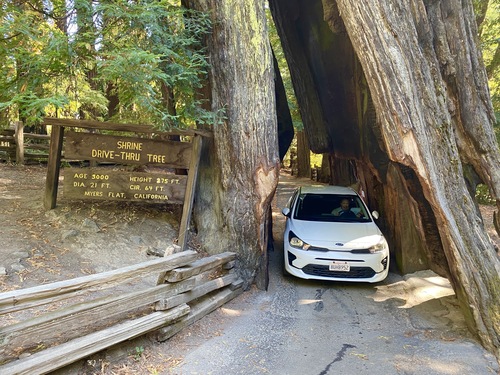 (Shrine Drive Thru Tree in California)
(Shrine Drive Thru Tree in California)
Shrine Drive Thru Tree
This is a redwood tree you can drive through without guilt. That’s because the tunnel in the trunk of this drive-through redwood tree was made by Mother Nature, not humankind.
The tree is privately owned, so there is a fee (usually $15 but make sure) to motor through, stop for photos, use the bathrooms, and browse the gift shop. Shrine is thought to be the world’s oldest drive-through redwood tree, but it’s probably younger than the 5,000 years claimed on the sign next to the tree.
The tree is located just off the Avenue of the Giants in the tiny town of Myers Flat. Chandelier is another drive-through redwood tree in the nearby town of Leggett.
Founders Grove
The easy, ADA-compliant half-mile hike here comes with its own guide booklet, available at the trailhead. The pamphlet contains instructions for a self-guided nature trail, and points out some of the (quite literal) high points of this grove.
Those include the towering Founders Tree, which stands 346 feet tall and is 40 feet around, and the Dyerville Giant, the largest fallen redwood tree on the planet at 360 feet long. This giant redwood is believed to be 1,600 years old. There’s also a giant redwood tree stump here that kids love to climb.
The grove’s parking lot is just off the Avenue of the Giants, on Dyerville Loop Road.
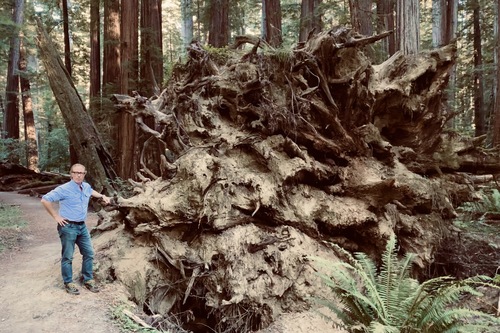 (Sculptural redwood tree roots in California's Founders Grove)
(Sculptural redwood tree roots in California's Founders Grove)
Rockefeller Forest
At 10,000 acres, the Rockefeller Forest is the stop to pick if you have time for a long, peaceful hike. Despite being home to countless redwood trees, including one of the tallest in these parts (a 370-foot "champion coast redwood" titleholder), Rockefeller doesn’t get the foot traffic of other groves because it’s far larger and requires more of a time commitment. It's close to Founders Grove along the Avenue of the Giants.
Humboldt Redwoods State Park Visitor Center
It’s not just the clean bathrooms, gift store, and informative staff that make this ranger station a must-stop along the Avenue of the Giants—though those are all certainly appreciated. But the center also has three excellent short documentaries about the area’s history and biology playing on a loop in the small theater, along with several smartly curated exhibits on display.
While you’re at the visitor center, ask for directions to the next site, which is off the Avenue of the Giants proper (but still part of the same redwood park).
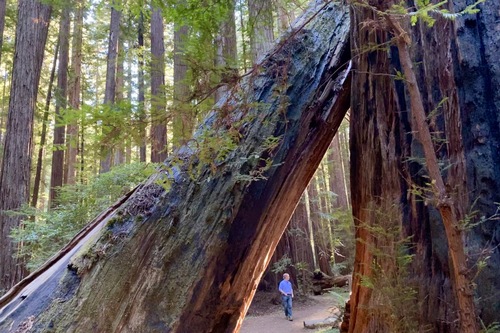 (Big Trees Day Use Area in California)
(Big Trees Day Use Area in California)
Big Trees Day Use Area
Your goal in going off the Avenue of the Giants proper is to see two of the largest redwood trees in this area: the aptly named Giant Tree, the Tall Tree, and the massive-yet-downed Flatiron Tree. All are worth the detour, especially if you've brought along a picnic. This lush area is quite scenic and, deeper in, less crowded than most other stops near the Avenue of the Giants.





